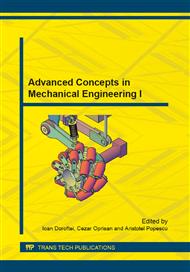p.161
p.167
p.173
p.177
p.183
p.189
p.195
p.201
p.207
Stress Analysis and Optimal Design of the Housing of a Two-Stage Gear Reducer
Abstract:
The design of the housings of the gear reducers is made, usually, using empirical equations based on the center distance (the distance between shafts). These equations can lead to inappropriate stresses distribution and inadequate material consumption at the final product. In the manufacturing of large series and in the manufacturing of the gear reducers/ gearboxes with large dimensions it is necessary an optimization of the housing dimensions. The use of the finite element analysis in this process, combined with experimental researches, can generate significant improvements. The paper is focused on the analysis of stresses distribution and displacements on the housing of a two-stage helical gear reducer with parametric dimensions and loads. The housing is subjected to a static finite element study. The optimization process aimed to minimize the total weight of the housing. The next features were submitted to dimensional changes: the thickness of the housing walls and the thickness of the ribs. The results presented as diagrams of stresses and displacements distributions show real opportunities to reduce the total weight of the housing and the material consumption.
Info:
Periodical:
Pages:
183-188
Citation:
Online since:
October 2014
Keywords:
Price:
Сopyright:
© 2014 Trans Tech Publications Ltd. All Rights Reserved
Share:
Citation:


